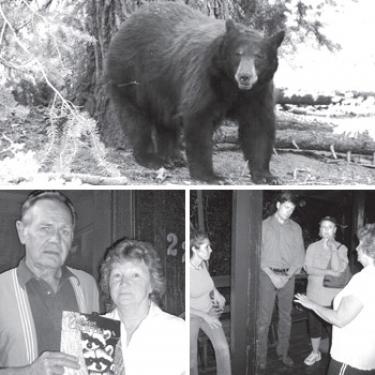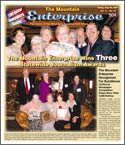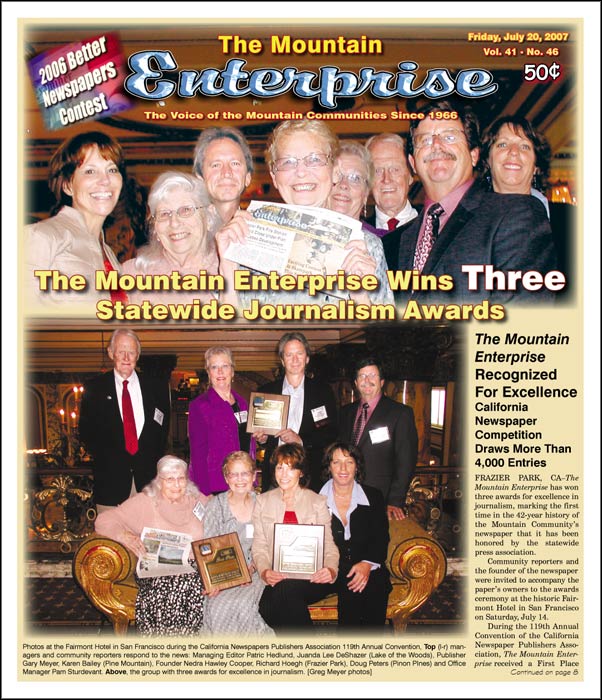
Top, young bear visiting El Camino Pines Campground this month?not the Goldilocks spotted at the Marvels and in other Pine Mountain homes recently. Bottom left, Tim and Bobbi Marvel are animal lovers who have had some unexpected night visitors that gave Bobbi quite a startle. Bottom right, Los Padres Bear Aware members listen to Bobbi Marvel (far right) relate how scared she was when the bear tried to break into her bedroom in the middle of the night. (l-r) Liz Bolden, Anders Hostmark, Judith Flannigan were understanding, as were other members of the group who had met earlier in the evening Tuesday, July 10. They were also concerned that the bear would be killed, as Bolden had been informed by Peter Cervantez, the USDA Wildlife Service trapper from Taft.
Trap Removed, but Family Still Upset at Attempts to Foil Efforts To Catch Intruder
Reported by Patric Hedlund and Jim McDevitt
Despite the infamous date, Friday the thirteenth may have been a lucky day for the mixed-up Goldilocks bear that has learned to break and enter into homes to raid refrigerators and freezers in Pine Mountain.
Joe Bennett, supervisor of this USDA Wildlife Service district, calculated Tuesday July 17 that, "based on a seven and 3/4 inch rear paw print" found near the scene of its recent crime, this bear is about five years old, weighing in at about 250 pounds, sex and color unknown.
Bennett’s office has an agreement with California Department of Fish and Game (DFG) to trap and remove bears designated as problems by DFG wildlife biologists.
Bennett’s wildlife specialist, Peter Cervantez, investigated the recent complaint and brought a "culvert trap" to the mountain on July 8 after DFG wildlife biologist Bill Asserson signed a depredation permit, a document which allows a bear to be trapped and killed because it has developed behaviors which could be a hazard to people and property.
The California Department of Fish and Game’s Statewide Black Bear Policy 2071 encourages trying other means first, but in this district, as Liz Bolden of the Los Padres Bear Aware project says, "a fed bear is a dead bear." They are trapped and usually killed.
In other parts of the state, bear relocation programs more closely follow the DFG statewide black bear policy (see the sidebar "Statewide Policy on Black Bears"at the end of this story). It recommends relocating and "hazing" (scaring) bears that stray into populated areas, but in southern California the bear population has grown rapidly just when drought, fire and housing developments are reducing both habitat and wildland corridors between habitats. More bears have been wandering into contact with human communities more frequently, especially in the summertime. People in these communities are often blind to the part we play in attracting animals in search of food, Bennet said.
Ripe fruit left on a tree, garbage cans with edible trash, dog food left outside, bird seed and hummingbird feeders, barbecue grills coated with cooking juices- the list goes on, through the hundreds of things most of us have never thought about, but which may spell a death sentence for a bear, because-unintentionally or not-we attract them to us.
On the recent Friday July 13 in question though, unexpected confusion about the stark facts was introduced by Lieutenant Tom Stenson and Game Warden Gary Densford from the law enforcement side of DFG-the part that deals with controlling the behavior of people more than animals.
Stenson and Densford made an impromptu visit to Pine Mountain Club Property Owners Association (PMCPOA) after hearing from sheriff’s deputies. They told officials Goldilocks may get a second chance to live in the wild as a wild animal should—but they had great concern about some residents trying to foil efforts to catch the bear in the trap that had been installed at the home of Thomas "Tim" and Wilma "Bobbi" Marvel.
The Marvels said they have felt besieged by both man and beast last week. On Friday, July 13 they called the state to have the trap removed because Bobbi was fearful, she said, after hearing of rumors that "someone was going to come to our house firing rubber bullets and paint guns." Tim Marvel said he wasn’t sure if the source of the rumor was discussion about ways to frighten bears, or if there were "angry people" who might wish to intimidate his family because the couple had called to have the bear trapped.
It all started in the middle of a hot night a couple of weeks ago. The bear attempted to crash through a window screen near where the Marvels were sleeping. They say Goldilocks was trying to get to a freezer in their walk-in bedroom closet. They believe it was following the scent of the freezer, which the bear had raided a few days earlier when the treasure chest of delectables was still located outside in an open car port.
About midweek, after the trap was in place in front of the car port, the Marvel’s neighbor Howard Galloway reported to The Mountain Enterprise that individuals were parking in front of the Marvels house during the night, making noises to keep the bear from approaching or entering the trap. Those tactics became as frightening to the Marvels as the bear itself, Tim Marvel said in an interview Monday, July 16.
"Just because Fish and Game comes in does not necessarily mean the bear is going to be killed," Lt. Stenson had told PMCPOA, asserting that the agency’s goal is to catch this bear in a trap and relocate it out of the area. "But Fish and Game protects the public and its property first, animals second," Densford said.
Interviews by The Mountain Enteprise with Densford on Tuesday, July 17 revealed that Stenson and Densford did not have complete information when they talked with PMCPOA officials about what this specific bear will face if it is caught. They did not know that biologist Asserson had already signed the depredation permit, which means that this bear will be killed if it is trapped.
Meanwhile, over the weekend, Anders Hostmark of Los Padres Bear Aware traveled to Lake Tahoe to consult with mentor organizations that have well-established bear programs in which law enforcement works closely with Bear Aware groups and residents to secure the safety of both people and the wild animals they live near.
Please see the article "Statewide Black Bear Policy" for a summary of the Fish and Game Department’s process that leads to a depredation permit to kill a bear.
| Statewide Black Bear Policy | |
| [printer friendly] | |
|
Please see related story "Fish and Game May Give Goldilocks Bear a Reprieve" which follows events surrounding a bear frequenting Pine Mountain homes for which a depredation permit has been issued. Department of Fish and Game The Department of Fish and Game’s bear depredation policy represents a progressive response system based upon the degree of damage being caused. The Department recognizes that the improper storage of human foods and garbage is the primary factor leading to bear/human conflicts. The reduction or elimination of bear attractants is therefore emphasized throughout Department policy so that bears do not become habituated to human food and become problem bears in the future. Bear situations are categorized and then addressed: Category 1 A bear strays into a populated area and cannot readily return to bear habitat. This bear has simply found itself in the wrong place. In most situations, removal of the antagonists or distractions from the area will allow the bear to return to nearby bear habitat with no other incident. Designated "no harm no foul," techniques to remove the bear may include, but are not limited to the use of sound makers, pepper spray, rubber slug shot shells or sling shot projectiles to drive the bear away or haze the bear out of the area. Tranquilizing and removing the bear can be used if other methods are determined to be unsafe or have been unsuccessful. Category 2 A bear becomes habituated to humans and may be a nuisance problem (no property damage involved) by tipping over garbage cans, invading compost piles, walking across porches, and so forth. Previously captured bears that have returned to areas of human habitation are included in this category. In these cases, the landowner or tenant is informed of reasonable corrective measures as a solution to the problem, which include but are not limited to: area cleanup, removal of trash or other food attractants, bear-proofing food storage areas, electric fencing, temporary closure of campsites. As mentioned in Category 1, techniques to remove the bear may include, but are not limited to the use of sound makers, rubber slug shot shells or sling shot projectiles to drive the bear away or haze the bear out of the area. Category 3 A bear causes real property damage to a dwelling(s), structure(s), vehicle(s), apiaries, etc., or is a repeat offender (the bear has been previously captured or hazed by DFG employees). If the damage is minor and there are no other previous reports of damage, the first action is implementation of reasonable corrective measures to remove attractants as outlined for the second category. Corrective measures must be made prior to, or in addition to, issuing a depredation permit. When a bear has caused extensive or chronic damage to private property (such as livestock killed or injured or entered into a home or cabin), repeated damage where corrective or bear-proofing efforts have failed, etc., DFG issues a depredation permit which orders the capture and killing of the problem bear. The procedures for disposing of bear taken under depredation permit will be determined prior to killing the bear. A Department employee will be responsible for the disposal of, or to verify disposal of such bear. Safe Passages: Coexisting with Your Wild Neighbors "The best methods for preventing bears from falling into any category in the DFG policy is for humans to live smartly in bear habitat. Taking the first step toward living responsibly in bear habitat will make the last step of the DFG bear policy unnecessary." |
|
This is part of the July 20, 2007 online edition of The Mountain Enterprise.
Have an opinion on this matter? We'd like to hear from you.


